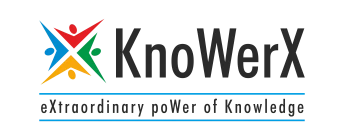How to Improve Supply Chain Efficiency?

Enhance Your Supply Chain Efficiency: Effective Tips & Solutions Supply chain efficiency refers to the effectiveness with which a company manages its supply chain processes, including procurement, production, transportation, and delivery, to minimise costs and maximise productivity. At KnoWerX, we emphasise teaching the seamless integration of these processes, ensuring the timely and optimal delivery of products to customers. Efficiency in the supply chain is not solely about speed; it involves crafting a streamlined, reliable, and cost-effective system that boosts overall business performance. Importance in Today’s Business Landscape In today’s highly competitive business environment, supply chain efficiency is crucial. It directly impacts a company’s bottom line by reducing operational costs, improving customer satisfaction, and increasing overall profitability. Companies with efficient supply chains can respond more quickly to market changes, manage risks better, and maintain a competitive edge. As global markets continue to evolve, the importance of supply chain efficiency cannot be overstated. It is a key differentiator that can make or break a business. Assess Current Supply Chain Performance Key Performance Indicators (KPIs) To improve supply chain efficiency, it is essential first to assess the current performance. This can be done by tracking key performance indicators (KPIs) such as order accuracy, delivery times, inventory turnover, and supply chain costs. These metrics provide a clear picture of where the supply chain stands and highlight areas needing improvement. Common KPIs include: Order Fulfillment Cycle Time: The total time taken from receiving an order to delivering the product to the customer. Perfect Order Rate: The percentage of orders delivered without any issues, such as delays, inaccuracies, or damage. Inventory Turnover Ratio: The number of times inventory is sold and replaced over a specific period. Supply Chain Cost per Unit: The total cost incurred in the supply chain process is divided by the number of units handled. Identifying Bottlenecks and Inefficiencies Once KPIs are measured, the next step is identifying bottlenecks and inefficiencies. These can occur at various points in the supply chain, such as production delays, transportation issues, or inventory mismanagement. Identifying these problem areas is crucial for developing targeted improvement strategies. By using techniques such as process mapping and root cause analysis, businesses can uncover hidden inefficiencies and develop actionable plans to address them, thereby boosting supply chain efficiency. Implement Advanced Technology Supply Chain Management Software Advanced technology plays a significant role in enhancing supply chain efficiency. Supply chain management (SCM) software helps streamline operations by providing real-time data, improving communication, and automating various processes. This software can manage everything from procurement to delivery, ensuring a smooth flow of goods and information. Features of SCM software include: Real-Time Inventory Tracking: Monitoring inventory levels across multiple locations in real-time. Order Processing Automation: Automating order processing to reduce manual errors and speed up order fulfillment. Supplier Management: Managing supplier relationships and performance through a centralized platform. Internet of Things (IoT) and Real-Time Tracking The Internet of Things (IoT) allows for real-time tracking of products and assets throughout the supply chain. IoT devices can monitor conditions such as temperature and humidity, ensuring that goods are handled correctly. Real-time tracking also provides visibility into the movement of products, helping to prevent delays and losses. Applications of IoT in supply chain efficiency include: Asset Tracking: Using IoT sensors to monitor the location and condition of assets such as vehicles, containers, and equipment. Environmental Monitoring: Ensuring that perishable goods are stored and transported under optimal conditions. Predictive Maintenance: Using data from IoT devices to predict and prevent equipment failures before they occur. Artificial Intelligence and Predictive Analytics Artificial Intelligence (AI) and predictive analytics can analyze vast amounts of data to forecast demand, optimize inventory levels, and identify potential disruptions before they occur. These technologies enable companies to make data-driven decisions, enhancing efficiency and reducing costs. Examples of AI applications in supply chain efficiency include: Demand Forecasting: Using machine learning algorithms to predict future demand based on historical data and market trends. Inventory Optimization: Automatically adjusting inventory levels based on predicted demand and current stock levels. Risk Management: Identifying potential risks and disruptions in the supply chain and developing mitigation strategies. Optimize Inventory Management Just-in-Time (JIT) Inventory Just-in-time (JIT) inventory management reduces waste and storage costs by receiving goods only as they are needed in the production process. This approach minimizes inventory holding costs and reduces the risk of overstocking or stockouts. Implementing JIT requires close coordination with suppliers and a deep understanding of demand patterns. When done correctly, JIT can significantly enhance supply chain efficiency by aligning inventory levels with actual consumption. Demand Forecasting Techniques Accurate demand forecasting is crucial for maintaining optimal inventory levels. By using historical data, market trends, and predictive analytics, companies can anticipate customer demand more accurately, ensuring that they have the right products in the right quantities at the right time. Effective demand forecasting reduces the likelihood of stockouts and overstock situations, contributing to supply chain efficiency by optimizing inventory turnover and reducing holding costs. Supplier Relationship Management Building strong relationships with suppliers is essential for efficient inventory management. Reliable suppliers can provide high-quality materials on time, reducing production delays and ensuring a steady supply of goods. Effective supplier relationship management involves regular communication, performance reviews, and collaborative planning. By fostering strong partnerships with suppliers, companies can improve supply chain efficiency through better coordination, reliability, and responsiveness. Streamline Transportation and Logistics Route Optimization Efficient transportation is a key component of a streamlined supply chain. Route optimization software can analyse various factors such as traffic, delivery schedules, and fuel costs to determine the most efficient routes. This reduces transportation time and costs while ensuring timely deliveries. Route optimization enhances supply chain efficiency by minimizing delays and maximizing resource utilization, ultimately leading to faster and more reliable delivery of goods. Carrier Selection and Management Selecting the right carriers and managing relationships with them is critical for effective logistics. Companies should evaluate carriers based on their reliability, cost, and service quality. Regular performance assessments and maintaining open communication with carriers can help ensure consistent and efficient
Essential Guide: Demand Forecasting for Inventory Management
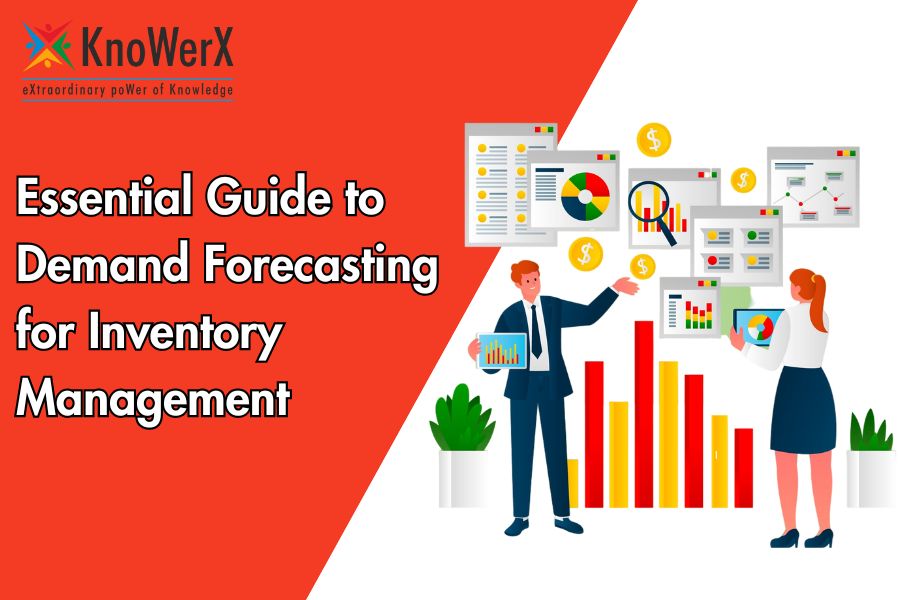
The Essential Guide to Demand Forecasting for Inventory Management Demand forecasting for inventory management is a critical process that helps businesses predict future customer demand for products or services. This essential practice allows companies to optimize their inventory levels, reduce costs, and improve customer satisfaction. In this article, we will explore the key aspects of demand forecasting for inventory management and how it can benefit your business. Key Techniques in Demand Forecasting Demand forecasting for inventory management involves both qualitative and quantitative methods. Qualitative techniques include market research and expert opinions, which can provide valuable insights into consumer trends and preferences. These methods are particularly useful when historical data is limited or when launching new products. Quantitative methods, on the other hand, rely on historical data and statistical analysis. Time series analysis examines past sales data to identify patterns and trends, while causal forecasting considers external factors that may influence demand. These approaches form the backbone of many demands forecasting for inventory management systems. Benefits of Accurate Demand Forecasting The benefits of accurate demand forecasting for inventory management are numerous. Firstly, it improves inventory turnover by ensuring that stock levels align closely with customer demand. This reduces the risk of overstocking, which ties up capital and increases storage costs. Conversely, it also minimizes the chances of stockouts, which can lead to lost sales and damaged customer relationships. Secondly, demand forecasting for inventory management helps reduce carrying costs. By maintaining optimal inventory levels, businesses can minimize the expenses associated with storing and managing excess stock. This includes costs related to warehousing, insurance, and potential obsolescence. Lastly, effective demand forecasting enhances customer satisfaction. By accurately predicting demand, companies can ensure product availability when customers need it, leading to improved service levels and customer loyalty. Challenges in Demand Forecasting However, demand forecasting for inventory management is not without its challenges. Market volatility can make predictions difficult, as sudden shifts in consumer behaviour or economic conditions can disrupt established patterns. Seasonal fluctuations also present a challenge, requiring businesses to adjust their forecasts based on time-of-year trends. Additionally, new product introductions can complicate forecasting efforts, as there’s often limited historical data to rely on. Demand forecasting challenges are data quality and integration, adapting to market volatility, and incorporating new data types. Organizations need to create adaptable forecasting models that can respond to such uncertainties. Furthermore, integrating new types of data, like sentiment analysis from social media, demands advanced analytical tools and expertise to convert into useful forecasts. What are the Future Trends of Demand Forecasting? Future trends in demand forecasting are the increased use of AI and machine learning, the integration of real-time data streams, and the development of more collaborative forecasting platforms. Here are some future trends in Demand Forecasting: AI and Machine Learning: There will be an increased reliance on artificial intelligence (AI) and machine learning (ML) algorithms for demand forecasting. These technologies can analyse large volumes of data and identify complex patterns that traditional methods might miss. AI and ML models can continuously learn and improve accuracy over time. Real-Time Data Integration: Demand forecasting will increasingly rely on real-time data streams from various sources such as IoT devices, social media, point-of-sale systems, and supply chain data. Integrating these real-time data streams allows for more accurate and responsive forecasting, especially in dynamic markets. Best Practices for Effective Demand Forecasting To overcome these challenges and implement effective demand forecasting for inventory management, businesses should follow several best practices. First, make extensive use of historical data when available. This provides a solid foundation for identifying trends and patterns in customer demand. Regular forecast reviews and updates are also crucial. Demand patterns can change quickly, so it’s important to continuously monitor and adjust forecasts as new information becomes available. This iterative process helps improve forecast accuracy over time. Collaboration with sales and marketing teams is another key aspect of successful demand forecasting for inventory management. These departments often have valuable insights into customer behaviour, upcoming promotions, and market trends that can inform more accurate forecasts. Technology and Tools for Demand Forecasting Technology plays an increasingly important role in demand forecasting for inventory management. Inventory management software can automate many aspects of the forecasting process, making it easier to analyse large volumes of data and generate accurate predictions. Advanced analytics and artificial intelligence are also being leveraged to improve forecast accuracy, particularly in complex environments with multiple variables affecting demand. FAQs: Frequently Asked Questions End Notes At KnoWerX, we understand that demand forecasting for inventory management is a cornerstone of effective supply chain operations. Our Certified Forecasting and Demand Management (CFDM) course is designed to equip professionals with the skills needed to excel in this critical area. We teach our students to leverage both qualitative and quantitative methods, harness cutting-edge technology, and implement industry best practices to significantly improve forecasting accuracy. The CFDM curriculum emphasizes how superior demand forecasting leads to optimized inventory management, reduced costs, and enhanced customer satisfaction. As markets evolve and competition intensifies, the importance of mastering demand forecasting for inventory management cannot be overstated. Our CFDM graduates are well-positioned to meet customer needs, control costs, and give their organizations a competitive edge in their respective industries. At KnoWerX, we believe that continuous improvement in forecasting techniques and processes is key to long-term success in inventory management, which is why our CFDM course is regularly updated to reflect the latest industry trends and technologies. Image Reference: Freepik Disclaimer: All trademarks, logos, and brand names are the property of their respective owners. All company, product, and service names used in this website are for identification purposes only. Use of these names, trademarks, and brands does not imply endorsement.
Six Sigma Green Belt Benefits Your Professional Growth

Tips for Leveraging Six Sigma Green Belt Benefits for Your Professional Growth At KnoWerX, we believe in empowering professionals through top-notch training and education in Supply Chain Management. With over 32 years of collective experience, our team has trained and consulted with numerous large companies both in India and abroad. One of the most impactful certifications you can pursue is the Six Sigma Green Belt. Here are some tips on how to maximize the benefits of your Six Sigma Green Belt certification. Apply Your Knowledge to Real-World Problems One of the key benefits of a Six Sigma Green Belt is the ability to identify and solve complex problems using data-driven methods. Start by applying your training to real-world scenarios in your workplace. Look for processes that can be improved and use Six Sigma tools like DMAIC (Define, Measure, Analyse, Improve, Control) to streamline operations, reduce waste, and improve quality. By leveraging the Six Sigma Green Belt benefits, you can make a significant impact on your organization’s efficiency and effectiveness, ultimately contributing to its overall success. For instance, you might work on reducing cycle times in your supply chain processes. By utilizing the skills learned during your Six Sigma Green Belt training, you can identify bottlenecks, collect and analyse data, and implement solutions that significantly enhance efficiency. One of the key Six Sigma Green Belt benefits is the ability to systematically approach such challenges, leading to measurable improvements and optimized operations within your organization. Enhance Team Collaboration and Leadership Skills Earning a Six Sigma Green Belt not only equips you with technical skills but also enhances your ability to lead and collaborate with teams. Use this opportunity to step up as a leader in your organization. Lead Six Sigma projects and mentor your peers on the methodologies and tools you have mastered. Effective communication and teamwork are critical to the success of any Six Sigma project. Share your knowledge and encourage a culture of continuous improvement within your team. This collaborative approach will not only lead to better project outcomes but also foster a positive work environment where everyone is committed to achieving excellence. Drive Career Advancement and Professional Recognition One of the most significant Six Sigma Green Belt benefits is the potential for career advancement. The certification is highly valued across industries, from manufacturing to healthcare, and can open doors to new opportunities and higher positions. Highlight your certification on your resume and during job interviews to showcase your commitment to quality and process improvement. At KnoWerX, we emphasize the importance of continuous learning and professional development. By keeping your Six Sigma skills sharp and staying updated with the latest industry trends, you can maintain your competitive edge. Participate in professional networks, attend workshops, and engage with the Six Sigma community to further your career growth. Implement Cost Reduction Strategies A fundamental benefit of Six Sigma Green Belt certification is the ability to drive cost reduction initiatives. Use your expertise to identify areas where your organization can save money without compromising quality. This could involve streamlining supply chain processes, improving resource allocation, or reducing defects and rework. At KnoWerX, we emphasize the importance of continuous learning and professional development. By keeping your Six Sigma skills sharp and staying updated with the latest industry trends, you can maintain your competitive edge and fully realize the Six Sigma Green Belt benefits. Participate in professional networks, attend workshops, and engage with the Six Sigma community to further your career growth and maximize the Six Sigma Green Belt benefits. Foster a Culture of Continuous Improvement One of the lasting Six Sigma Green Belt benefits is the ability to instill a culture of continuous improvement within your organization. Encourage your colleagues to embrace Six Sigma principles and methodologies in their daily work. Promote ongoing training and development to ensure that everyone is equipped with the skills necessary to contribute to process improvement efforts. As a Six Sigma Green Belt, your role is to lead by example and drive initiatives that promote efficiency, quality, and customer satisfaction. By leveraging the numerous Six Sigma Green Belt benefits, you foster a mindset of continuous improvement, helping create a dynamic and innovative work environment. This approach allows your organization to adapt to changing market demands and stay ahead of the competition, ensuring long-term success and growth. Frequently Asked Questions End Notes The Six Sigma Green Belt benefits are vast and can significantly enhance your professional journey. At KnoWerX, we are committed to providing you with the best quality education and training to help you achieve excellence in your career. Embrace these tips and leverage your Six Sigma Green Belt certification to drive success and growth within your organization. Image Reference: Freepik Disclaimer: All trademarks, logos, and brand names are the property of their respective owners. All company, product, and service names used in this website are for identification purposes only. Use of these names, trademarks, and brands does not imply endorsement.
Importance of Integrated Business Planning in Operations
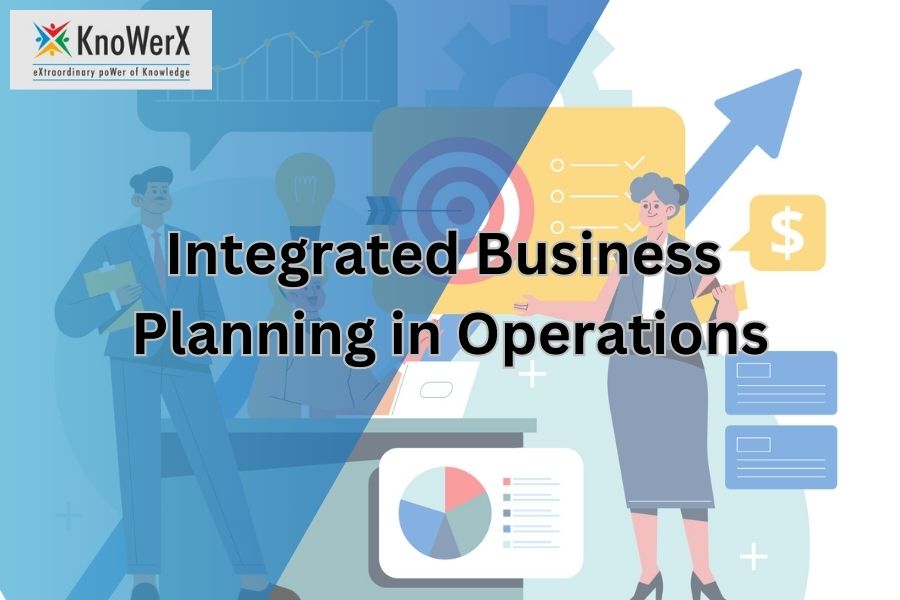
Recognizing the Importance of Integrated Business Planning in Operations Integrated Business Planning (IBP) is a strategic management process that aligns business functions and departments to collaboratively plan and execute operational activities. The importance of Integrated Business Planning lies in its primary goal of integrating financial planning with operational planning across an organization, ensuring alignment of resources, priorities, and goals. IBP enhances decision-making by providing a holistic view of the business, enabling better forecasting, resource allocation, and risk management. It helps businesses achieve greater agility, responsiveness to market changes, and overall performance improvement. Alignment of Business Goals Integrated Business Planning (IBP) ensures alignment of strategic objectives with operational plans by coordinating activities across departments to achieve unified goals. The importance of Integrated Business Planning lies in its ability to synchronize diverse functions, such as finance, marketing, sales, operations, and supply chain, to work collaboratively towards common business objectives. Here’s how it achieves this: Strategic Alignment: IBP integrates strategic objectives into operational plans by linking long-term goals with short-term actions. This alignment ensures that day-to-day activities contribute directly to achieving broader organizational objectives. Collaborative Planning: IBP fosters collaboration across departments. It involves key stakeholders from finance, sales, marketing, supply chain, and other functions in the planning process. This collaboration ensures that everyone is working towards common objectives and understands how their activities impact overall performance. Resource Optimization: By coordinating activities and aligning goals, IBP helps optimize resource allocation. It ensures that resources such as finances, personnel, and materials are deployed efficiently to support strategic priorities. Enhanced Decision-Making Importance of Integrated Business Planning (IBP) enhances decision-making by leveraging real-time data and improving forecasting accuracy and risk management in the following ways. Real-Time Data Utilization: IBP integrates real-time data from various sources across the organization, such as sales figures, inventory levels, and market trends. This allows decision-makers to have up-to-date information to base their decisions on, rather than relying on outdated or incomplete data. Improved Forecasting: IBP incorporates advanced forecasting techniques and algorithms to predict future demand, sales trends, and resource needs more accurately. By analysing historical data and market insights in real-time, IBP helps organizations anticipate changes and make proactive decisions to meet customer demands effectively. Risk Management: IBP enhances risk management by identifying potential risks early and developing strategies to mitigate them. It allows organizations to assess the impact of various scenarios on their operations and financial performance, thereby improving resilience and preparedness against uncertainties. Optimized Resource Allocation Integrated Business Planning (IBP) optimizes resource allocation by ensuring efficient use of financial, human, and material resources, thereby reducing wastage and enhancing productivity. Here’s how IBP achieves this: Financial Resource Allocation: IBP aligns financial planning with operational goals, ensuring that budgets are allocated strategically to support priority initiatives. By integrating financial forecasts with operational plans, IBP helps organizations allocate funds where they are most needed, avoiding overspending or underspending in different areas. Human Resource Optimization: IBP involves workforce planning based on anticipated demand and business priorities. It ensures that the right talent is deployed in the right roles at the right time, optimizing employee productivity and satisfaction. Additionally, IBP facilitates workforce development initiatives aligned with organizational goals, enhancing skills and capabilities where necessary. Material Resource Management: IBP improves inventory management and procurement processes by aligning them with demand forecasts and production schedules. It helps organizations maintain optimal inventory levels to meet customer demand while minimizing carrying costs and stockouts. By integrating supply chain planning with sales and operations, IBP reduces inefficiencies in material handling and logistics. Enhanced Productivity: By optimizing resource allocation across financial, human, and material dimensions, IBP enhances overall productivity. It ensures that resources are used efficiently to achieve maximum output and deliver value to customers and stakeholders. Moreover, IBP fosters a culture of continuous improvement and accountability, where resources are managed responsibly to drive sustainable growth and profitability. Improved Collaboration The Importance of Integrated Business Planning (IBP) lies in its ability to improve collaboration by promoting cross-functional communication and breaking down silos between departments, fostering integrated workflows across the organization. Here’s how IBP enhances collaboration. Cross-Functional Communication: IBP involves key stakeholders from various departments, including finance, sales, marketing, supply chain, and operations, in the planning and decision-making processes. This cross-functional collaboration ensures that different perspectives are considered, fostering a more comprehensive understanding of business needs and objectives. Shared Goals and Objectives: IBP aligns all departments towards common goals and objectives. By integrating strategic and operational planning, IBP ensures that everyone understands their role in achieving organizational success. This shared understanding promotes teamwork and collective accountability across the organization. Information Sharing: IBP facilitates the sharing of information and data across departments in real-time. This transparency enables teams to access relevant insights and collaborate more effectively on projects and initiatives. It reduces the likelihood of misunderstandings or conflicting priorities, promoting smoother workflows and faster decision-making. Agility and Responsiveness The importance of Integrated Business Planning (IBP) lies in its ability to enhance agility and responsiveness within organizations. IBP enables organizations to adapt swiftly to market changes and disruptions, facilitating quick responses to customer demands and market shifts. Here’s how IBP achieves this. Real-Time Data and Insights: IBP leverages real-time data from various sources, providing organizations with up-to-date insights into market conditions, customer behaviour, and internal operations. This timely information allows businesses to quickly identify emerging trends and make informed decisions to stay ahead of the competition. Scenario Planning and Analysis: IBP supports scenario planning, allowing organizations to model different potential outcomes based on various assumptions and variables. By simulating different scenarios, businesses can prepare for potential market shifts and disruptions, developing contingency plans to mitigate risks and capitalize on opportunities. Flexible Planning Processes: Importance of Integrated Business Planning (IBP) promotes flexible and iterative planning processes that can be adjusted as needed. This flexibility enables organizations to pivot quickly in response to changing market conditions, ensuring that plans remain relevant and effective even in dynamic environments. Aligned and Collaborative Teams: With IBP, cross-functional teams are aligned and work collaboratively towards shared goals. This alignment
Choosing the Best APICS Certification for Your Career Path
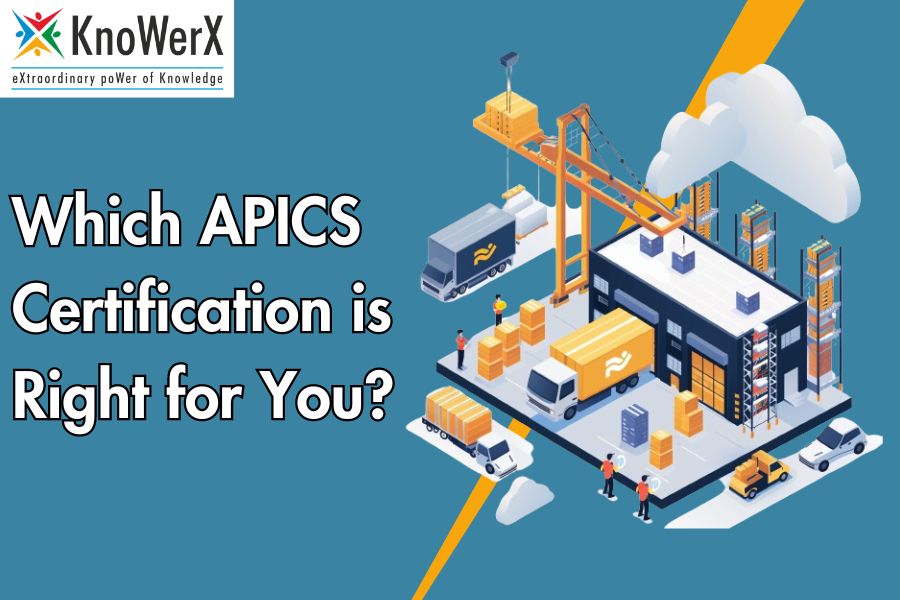
Which APICS Certification is Right for You? In the dynamic field of supply chain and operations management, certifications are crucial for career advancement and professional development. KnoWerX, a leading institute in supply chain management, offers various APICS certifications tailored to different aspects of the supply chain profession. This article explores the various APICS certifications to help you determine which one aligns with your career goals and professional needs. APICS Certification Overview APICS certifications, recognized globally, offer numerous benefits, including strengthened knowledge, improved job performance, and increased career opportunities. Whether you’re just starting in your career or looking to advance to a leadership role, an APICS certification from KnoWerX can provide the skills and recognition you need to succeed. Detailed Breakdown of Each APICS Certification APICS CPIM (Certified in Planning and Inventory Management) Focus Areas: The CPIM certification covers key topics such as demand management, procurement and supplier planning, material requirements planning, capacity planning, sales and operations planning, and master scheduling. Ideal Candidates: This certification is best suited for professionals involved in production and inventory management, including planners, buyers, and inventory managers. It is also valuable for those looking to improve their understanding of internal operations and the supply chain. APICS CLTD (Certified in Logistics, Transportation, and Distribution) Focus Areas: The CLTD certification focuses on logistics, transportation, and distribution concepts. This includes logistics strategy, network design, sustainability, reverse logistics, and the roles of transportation and distribution in the supply chain. Ideal Candidates: This certification is ideal for professionals working in logistics, distribution, and transportation roles, such as logistics managers, transportation managers, and distribution managers. It is also beneficial for those looking to optimize their supply chain’s logistics and distribution aspects. APICS CSCP (Certified Supply Chain Professional) Focus Areas: The CSCP certification covers end-to-end supply chain management, including supply chain design, planning, execution, monitoring, and control. It emphasizes the integration of operations across the supply chain to enhance performance. Ideal Candidates: This certification is suited for professionals seeking to deepen their knowledge of supply chain management and those aiming for leadership roles. It is also valuable for individuals working in various supply chain functions, such as procurement, manufacturing, and distribution. APICS CTSC (Certified in Transformation for Supply Chain) Focus Areas: The CTSC certification focuses on digital transformation and technological advancements in the supply chain. It includes topics such as process improvement, data analytics, and the integration of new technologies into supply chain operations. Ideal Candidates: This certification is ideal for professionals looking to specialize in the integration of new technologies and digital transformation within supply chains. It is also valuable for those interested in driving innovation and improving processes through technology. When choosing between APICS certifications, consider the key differences and similarities between them. Each certification caters to different aspects of supply chain management, so it’s important to align your choice with your career goals, current job role, industry demands, and personal interests. Steps to Choose the Right Certification Self-Assessment: Begin by evaluating your current career stage, professional interests, and long-term goals. Reflect on the skills and knowledge you need to advance in your career. Consider your strengths, areas for improvement, and the specific expertise required for your desired path. Research: Gather detailed information about each APICS certification. Look into the curriculum, exam format, prerequisites, and study resources for each certification. Review the official APICS website and other reputable sources to understand the topics covered and the depth of knowledge required. Consultation: Seek advice from mentors, industry professionals, and individuals who have obtained APICS certifications. Their insights can provide valuable perspectives on the real-world benefits and challenges of each certification. Engage in conversations, attend industry seminars, and participate in professional forums to gather diverse opinions. By following these steps, you can choose the APICS certification that best aligns with your career objectives and professional development needs. FAQs: Frequently Asked Questions End Notes Choosing the right APICS certification from KnoWerX is a significant step towards advancing your career and enhancing your professional knowledge. Each certification offers unique benefits and caters to different aspects of supply chain management. By carefully considering your career goals and interests, you can select the certification that best aligns with your needs and sets you on a path to success. Image Reference: Freepik Disclaimer: All trademarks, logos, and brand names are the property of their respective owners. All company, product, and service names used in this website are for identification purposes only. Use of these names, trademarks, and brands does not imply endorsement.
Supply Chain Professionals: Key to Enhancing Sustainability

What Role Do Supply Chain Professionals Play in Enhancing Sustainability? In today’s rapidly evolving business landscape, enhancing sustainability is more crucial than ever. Supply chain professionals play a crucial role in driving sustainable practices within organizations. Their expertise and strategic decisions impact everything from procurement and logistics to waste management and energy efficiency. By integrating sustainability into every aspect of supply chain management, these professionals can help organizations reduce their environmental footprint, achieve long-term cost savings, and foster a positive reputation. Here are some key tips on how supply chain professionals can enhance sustainability. Implementing Green Procurement Practices Supply chain professionals are responsible for sourcing materials and services. By prioritizing suppliers who follow sustainable practices, they can significantly reduce the environmental impact of their operations. This includes selecting suppliers with eco-friendly certifications and focusing on materials that are recyclable or biodegradable. Optimizing Transportation and Logistics Transportation is a significant contributor to carbon emissions. Supply chain professionals can enhance sustainability by optimizing logistics operations. This includes route optimization to reduce fuel consumption, utilizing energy-efficient vehicles, and consolidating shipments to minimize the number of trips. Promoting Energy Efficiency Energy consumption is a major factor in the sustainability equation. Supply chain professionals can advocate for and implement energy-efficient practices within their operations. This includes investing in energy-efficient machinery, adopting renewable energy sources, and implementing smart energy management systems. Reducing Waste Minimizing waste is a crucial aspect of sustainability. Supply chain professionals can enhance sustainability by adopting lean manufacturing principles and waste reduction strategies. This involves streamlining processes to reduce excess materials, implementing recycling programs, and reusing materials whenever possible. Enhancing Product Lifecycle Management Sustainable product lifecycle management is essential for reducing environmental impact. Supply chain professionals can enhance sustainability by designing products for longevity, ease of repair, and end-of-life recyclability. This also involves working closely with product development teams to incorporate sustainable materials and processes from the outset. Fostering Collaboration and Innovation Sustainability is a collective effort. Supply chain professionals can drive sustainability by fostering collaboration and innovation within their networks. This includes working with suppliers, customers, and other stakeholders to develop and implement sustainable practices and technologies. Ensuring Compliance with Sustainability Development Adhering to sustainability standards and regulations is essential for responsible business practices. Supply chain professionals must stay informed about relevant laws and regulations, ensuring their operations comply with these standards. This not only enhances sustainability development but also helps to avoid legal and financial repercussions. Measuring and Reporting Sustainability Metrics Effective sustainability initiatives require accurate measurement and reporting. Supply chain professionals can enhance sustainability by implementing robust metrics and reporting systems to track their progress. This includes measuring carbon footprint, waste generation, and energy consumption, and transparently reporting these metrics to stakeholders. Educating and Training Teams Building a culture of sustainability requires education and training. Supply chain professionals can play a vital role in enhancing sustainability by educating and training their teams on sustainable practices. This includes conducting workshops, providing resources, and encouraging continuous learning and improvement. Leveraging Technology for Sustainable Solutions Technology plays a crucial role in driving sustainability. Supply chain professionals can enhance sustainability by leveraging advanced technologies such as AI, blockchain, and IoT for better supply chain visibility, efficiency, and sustainability. These technologies can help in tracking sustainability metrics, optimizing routes, and ensuring transparency throughout the supply chain. FAQs: Frequently Asked Questions End Notes At KnoWerX, we understand the critical role supply chain professionals play in enhancing sustainability. As an industry leader in Supply Chain Management Training, we empower professionals through our professional training programs and high-quality education. With a collective experience of over 75 years, our team has been in the education and consultancy field for 25+ years, working with and training large companies in India and abroad. We are committed to providing the best quality education at the best price possible. KnoWerX is your one-stop destination to learn best practices, acquire domain knowledge, and obtain relevant certifications for professional growth. Join us in our mission to drive sustainability and excellence in the supply chain industry. Image Reference: Freepik Disclaimer: All trademarks, logos, and brand names are the property of their respective owners. All company, product, and service names used in this website are for identification purposes only. Use of these names, trademarks, and brands does not imply endorsement.
Key Skills of a Demand Driven Leader Professional

What Skills Define a Demand Driven Leader Professional? In today’s rapidly evolving business landscape, the role of a Demand Driven Leader Professional has become increasingly crucial. As markets fluctuate, consumer preferences shift, and supply chains face unprecedented challenges, organizations require leaders who can navigate these complexities with agility and foresight. A Demand-Driven Leader Professional is not only adept at understanding market demands but also possesses the strategic acumen to align resources, optimize processes, and drive innovation throughout the supply chain. KnoWerX offers the Demand Driven Leadership Professional (DDLP) course, approved by the Demand Driven Institute to equip professionals with the skills and knowledge necessary to lead effectively in a demand-driven environment. Through our comprehensive training programs and industry insights, we empower individuals to become catalysts for organizational success in today’s dynamic business environment. Adaptive Decision Making Demand driven leader professional must make quick and informed decisions in response to changing market dynamics. Develop the ability to analyse data swiftly, assess risks, and adapt strategies accordingly. Remember, flexibility is key; be open to innovative solutions and willing to pivot when necessary to stay ahead of the curve. Strategic Planning Effective Demand driven leader professional anticipate market demands and proactively develop strategies to meet them. Sharpen your strategic planning skills to align your organization’s resources with future demand fluctuations. By fostering a forward-thinking mindset, you’ll be better equipped to identify emerging trends and capitalize on new opportunities. Cross-Functional Collaboration Collaboration is key in demand-driven environments. Cultivate strong relationships across departments to facilitate seamless communication and coordination. Recognize the value of diverse perspectives and foster a collaborative culture that encourages teamwork and innovation. Customer-Centric Mindset Understand your customers’ needs and preferences to drive customer-centric decision making. Incorporate customer feedback into your strategies to ensure products and services meet market demand. By prioritizing customer satisfaction, you’ll build brand loyalty and gain a competitive edge in the marketplace. Supply Chain Optimization In a demand-driven environment, supply chain efficiency is paramount. Leaders proficient in supply chain management can synchronize production, distribution, and inventory levels with fluctuating demand patterns. They implement lean principles, establish robust supplier relationships, and utilize technology to achieve seamless coordination across the supply chain. DDLP™ Certificate Maintenance DDLP™ certificate holders are required to have 20 Continuing Education Units (CEU) every five years to maintain their endorsement. Each CEU is equivalent to 1 hour of “qualified content”. A list of qualified content is included below: Attendance of DDI produced webinars Watching available videos on the DDI website Watching available videos through DDI’s on demand system Watching the latest recording of the Demand Driven Leader (DDL)™ Program Attendance of a Demand Driven World™ Conference Attendance of other DDI educational products (Demand Driven Leader™, Adaptive Enterprise Foundations™, Precisely Wrong Workshop™, etc.) Attendance of DDI Affiliates and event partners (look for the DDLP™ CEU Qualified Content logo) Attendance of other qualified offerings (look for the DDLP™ CEU Qualified Content logo) Subsequent achievement of AEFP™, DDPP™, ASTP™, DDSCP™ professional endorsement – 10 points An application for endorsement maintenance must be filled out and submitted to DDI. A list of qualified content must be itemized as per the application form and signed by the applicant. That’s why at KnoWerX, we offer a comprehensive Certificate Maintenance program designed specifically for demand driven leaders professional. Our program provides ongoing education and training opportunities to ensure that professionals remain up-to-date with the latest industry trends, best practices, and emerging technologies. Through a combination of workshops, webinars, and online courses, participants have the opportunity to deepen their understanding of demand-driven principles and strategies while earning continuing education credits. Change Management Change Management for Demand Driven Leader Embrace change as a constant in the demand driven landscape. Develop change management skills specific to demand driven leadership to lead your team through transitions and ensure smooth implementation of new processes and technologies. Foster a culture of adaptability and resilience to navigate change effectively and drive organizational growth. Continuous Learning Stay abreast of industry trends, best practices, and emerging technologies to remain competitive as a demand driven leader. Invest in continuous learning through professional training programs and certifications to enhance your skills and expertise. Embrace lifelong learning as a cornerstone of professional development and commit to staying ahead of the curve in the rapidly evolving field of supply chain management. FAQs: Frequently Asked Questions End Notes At KnoWerX, we’re committed to empowering professionals like you with the knowledge and skills needed to thrive in demand driven leader professional roles. Explore our comprehensive training programs and unlock your potential for success in today’s dynamic supply chain environment with KnoWerX. With our industry-leading instructors and cutting-edge curriculum, you’ll gain practical insights and hands-on experience to excel as a demand driven leader in your organization. Join us on the path to professional growth and achievement.
How Inventory Management Officer Enhance Inventory Accuracy?
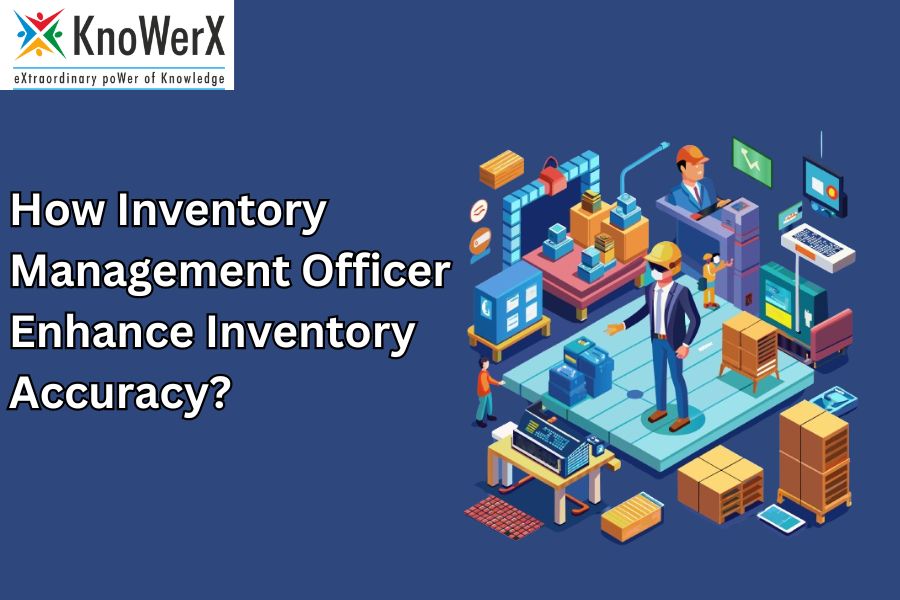
How Can an Inventory Management Officer Enhance Inventory Accuracy? Inventory accuracy is a critical component of efficient supply chain management. An Inventory Management Officer plays a pivotal role in ensuring that the inventory records align with the physical inventory. By implementing regular cycle counts and audits, discrepancies can be identified and resolved promptly. Additionally, leveraging technology such as RFID and barcode systems can greatly improve tracking accuracy. Here are some tips on how an Inventory Management Officer can enhance inventory accuracy, KnoWerX is proud to offer the Certified Inventory Management Officer (CIMO) course, designed to equip professionals with the knowledge and skills needed to excel in inventory management. Implement Regular Inventory Audits Implementing regular inventory audits is a critical practice for maintaining the accuracy and integrity of inventory records in any business. These audits involve systematically counting and verifying the physical inventory against the recorded data to identify discrepancies, such as overstocking, understocking, or misplacement of items. Regular audits help in detecting theft, shrinkage, and errors in data entry, thus ensuring reliable inventory management. They also aid in optimizing stock levels, reducing holding costs, and improving overall operational efficiency. Utilize Advanced Inventory Management Software Utilizing advanced inventory management software offers businesses enhanced capabilities to efficiently track, manage, and optimize their inventory processes. This software integrates real-time data analytics, automated stock monitoring, and predictive forecasting to minimize stockouts and overstock situations. By leveraging advanced algorithms and machine learning, it provides insightful reports and dashboards, facilitating informed decision-making. Additionally, it often includes features such as barcode scanning, RFID tracking, and integration with other business systems like ERP and CRM. These capabilities streamline operations, reduce manual errors, improve supply chain visibility, and ultimately enhance customer satisfaction and profitability. Benefits of Improving Inventory Management Improving inventory management offers several significant benefits that can positively impact a business’s overall performance. Effective inventory management minimizes excess stock and reduces storage costs, leading to better cash flow and higher profitability. It ensures that products are available to meet customer demand, thereby enhancing customer satisfaction and loyalty. Additionally, it reduces the risk of stockouts and overstock situations, optimizing the supply chain and preventing lost sales opportunities. Train and Educate Staff Training and educating staff is crucial for the effective implementation of inventory management. Comprehensive training programs equip employees with the necessary skills and knowledge to handle inventory efficiently, reducing errors and improving productivity. This involves educating staff on inventory control procedures, the use of inventory management software, and best practices for tracking and reporting. By ensuring that all team members are well-versed in inventory management techniques, businesses can streamline operations, maintain accurate stock levels, and enhance overall organizational performance. Establish Clear Communication Channels Establishing clear communication channels is essential for effective inventory management. Clear communication ensures that all stakeholders, from suppliers to warehouse staff and sales teams, are on the same page regarding inventory levels, order statuses, and replenishment schedules. This minimizes the risk of stockouts or overstock situations, which can disrupt operations and affect customer satisfaction. Utilizing tools such as inventory management software, regular meetings, and transparent reporting mechanisms helps streamline communication, allowing for real-time updates and quicker decision-making. By prioritizing clear communication, businesses can enhance their inventory management processes, leading to more efficient operations and better resource allocation. Monitor and Analyse Inventory Metrics Effective Inventory Management is crucial for businesses to maintain optimal stock levels and meet customer demands without overstocking or stockouts. Monitoring and analysing inventory metrics involves tracking key performance indicators (KPIs) such as inventory turnover, order accuracy, carrying costs, and stock levels. By regularly evaluating these metrics, businesses can identify trends, uncover inefficiencies, and make data-driven decisions to improve their inventory processes. FAQs: Frequently Asked Questions End Notes Enhancing inventory accuracy is a continuous process that requires diligence, the right tools, and well-trained staff. By implementing regular audits, utilizing advanced software, training staff, establishing clear communication channels, and monitoring key metrics, an Inventory Management Officer can significantly improve inventory accuracy. KnoWerX is dedicated to empowering professionals through our comprehensive training programs and high-quality education including course of CIMO (Certified Inventory Management Officer). With over 75 years of collective experience, we are committed to providing the best industry practices, domain knowledge, and relevant certifications for professional growth. Join KnoWerX and enhance your skills in inventory management and beyond. Image Reference: Freepik Disclaimer: All trademarks, logos, and brand names are the property of their respective owners. All company, product, and service names used in this website are for identification purposes only. Use of these names, trademarks, and brands does not imply endorsement.
10 Best Practices for Advanced Supply Chain Planning

What Are the Best Practices for Implementing Advanced Supply Chain Planning? In the ever-evolving landscape of supply chain management, advanced supply chain planning is crucial for achieving efficiency, reducing costs, and staying competitive. At KnoWerX, we leverage our extensive experience and deep industry knowledge to help professionals master these complexities. Here are some best practices for implementing advanced supply chain planning: Integrate Technology Solutions Utilize advanced software solutions such as ERP (Enterprise Resource Planning) and APS (Advanced Planning and Scheduling) systems. These tools can enhance data visibility, streamline processes, and improve decision-making. Implementing the right technology is foundational for any advanced supply chain planning strategy. Data Accuracy and Management Ensure that your data is accurate and up-to-date. Poor data quality can lead to ineffective planning and decision-making. Regularly audit your data sources and implement robust data management practices to maintain the integrity of your advanced supply chain planning information. Collaborate with Stakeholders For advanced supply chain planning to be effective, it’s important to work together with different departments and outside partners. Encourage open communication and cooperation with suppliers, distributors, and internal teams to make sure everyone is on the same page and working towards the same goals. Demand Forecasting Invest in accurate demand forecasting methods. Use historical data, market analysis, and predictive analytics to anticipate demand accurately. This helps in minimizing overstock and stockouts, ensuring a balanced inventory through advanced supply chain planning. Continuous Improvement Adopt a mindset of continuous improvement. Regularly review and refine your supply chain processes. Implement feedback loops and performance metrics to identify areas for improvement and to drive ongoing enhancements in efficiency and effectiveness within your advanced supply chain planning framework. Risk Management Develop a comprehensive risk management strategy. Identify potential risks within your supply chain, such as supplier disruptions, geopolitical issues, or natural disasters. Create contingency plans to mitigate these risks and ensure resilience as part of your advanced supply chain planning. Sustainability Practices Incorporate sustainability into your advanced supply chain planning. Opt for eco-friendly practices, optimize logistics to reduce carbon footprints, and ensure that your supply chain partners adhere to sustainable standards. This not only benefits the environment but can also improve your brand reputation. Skill Development and Training Invest in continuous learning and professional development. At KnoWerX, we offer specialized training programs designed to keep professionals abreast of the latest industry trends and best practices. Equip your team with the knowledge and skills necessary to implement advanced supply chain planning strategies effectively. Leveraging Analytics Use advanced analytics to gain insights into your supply chain operations. Data analytics can help identify patterns, predict trends, and uncover opportunities for optimization. Leveraging analytics ensures informed decision-making and strategic planning in advanced supply chain planning. Customer-Centric Approach Always keep the end customer in mind. Your advanced supply chain planning strategy should align with customer expectations and enhance their overall experience. Strive to deliver high-quality products in a timely and cost-effective manner to maintain customer satisfaction and loyalty. Benefits of Advanced Supply Chain Planning Implementing advanced supply chain planning brings numerous benefits, including improved operational efficiency, reduced costs, enhanced agility, and better alignment with market demands. It enables companies to respond swiftly to changes, optimize resource utilization, and achieve higher levels of customer satisfaction. Ultimately, it provides a significant competitive advantage in the marketplace. FAQs: Frequently Asked Questions End Notes Implementing these best practices can significantly enhance your supply chain planning processes, ensuring greater efficiency, cost-effectiveness, and competitive advantage. At KnoWerX, our mission is to empower supply chain professionals through high-quality education and training, equipping them with the tools and knowledge needed to excel in their careers. For more information on our professional training programs and how we can help you advance your supply chain planning capabilities, visit KnoWerX today. Let’s build a more efficient and resilient supply chain together. Image Reference: Freepik Disclaimer: All trademarks, logos, and brand names are the property of their respective owners. All company, product, and service names used in this website are for identification purposes only. Use of these names, trademarks, and brands does not imply endorsement.
Unlock the Power of Effective Integrated Business Planning

What Are the Key Steps in an Effective Integrated Business Planning Process? At KnoWerX, we specialize in Supply Chain Management training, offering high-quality education and professional programs designed to empower professionals to achieve success and excellence. With over 75 years of collective experience in education and consultancy, we are dedicated to providing the best quality education at the most competitive prices. As part of our commitment to excellence, we offer the CIBP (Certified Integrated Business Planner) course. Here are some essential tips for an effective Integrated Business Planning process: Align Strategic and Operational Goals To ensure a successful Integrated Business Planning process, align your strategic goals with operational objectives. This alignment helps create a cohesive plan that supports long-term business success and ensures all departments are working towards common goals. Foster Cross-Functional Collaboration Effective Integrated Business Planning requires collaboration across all departments. Encourage regular communication and joint planning sessions to ensure all teams are working towards the same objectives. This collaborative approach helps to identify and resolve potential issues early, leading to more efficient and effective planning. Leverage Data-Driven Insights Utilize advanced analytics and data-driven insights to inform your Integrated Business Planning. Accurate data helps in forecasting demand, managing inventory, and optimizing supply chain operations. This approach not only enhances efficiency but also drives better financial performance by minimizing costs and maximizing resource utilization. Implement Robust Technology Solutions Invest in technology solutions that support Integrated Business Planning. Tools like advanced planning software can help streamline processes, improve accuracy, and enhance decision-making capabilities. Additionally, these technologies can provide real-time visibility into operations, allowing for quicker adjustments and more agile responses to market changes. Conduct Regular Reviews and Adjustments Regularly review and adjust your Integrated Business Planning process. This ensures that the plan remains relevant and responsive to changing market conditions and business needs. By doing so, you can proactively address potential issues and capitalize on new opportunities. Ensure Leadership Commitment Leadership commitment is crucial for the success of Integrated Business Planning. Leaders should actively participate in the planning process and provide clear guidance and support to their teams. Additionally, they should ensure that the necessary resources are allocated to facilitate effective implementation and execution of the plan. Focus on Continuous Improvement Continuous improvement is key to an effective Integrated Business Planning process. Regularly assess performance, identify areas for improvement, and implement necessary changes to enhance efficiency and effectiveness. This proactive approach ensures that your planning process remains agile and responsive to evolving business needs. Train and Educate Your Team Invest in training and education for your team. At KnoWerX, we offer comprehensive training programs, including the CIBP certification, to equip professionals with the skills and knowledge required for effective Integrated Business Planning. Maintain Transparency and Accountability Transparency and accountability are essential in Integrated Business Planning. Ensure that all team members understand their roles and responsibilities and are held accountable for their contributions to the plan. Utilize Scenario Planning Incorporate scenario planning into your Integrated Business Planning process. This helps prepare your organization for various potential outcomes and ensures you can adapt quickly to changes. Benefits of CIBP (Certified Integrated Business Planner) professionals in the field of supply chain management and beyond. This certification signifies a deep understanding of Integrated Business Planning processes and best practices, equipping individuals with the skills needed to drive strategic alignment and operational efficiency within their organizations. With CIBP, professionals can enhance their ability to forecast demand, optimize inventory levels, and streamline supply chain operations, leading to improved decision-making and business performance. The certification also fosters cross-functional collaboration, ensuring that all departments work cohesively towards common objectives. FAQs: Frequently Asked Questions End Notes Additionally, CIBP holders are recognized for their expertise and commitment to continuous improvement, which can lead to increased career opportunities and professional growth. At KnoWerX, we are dedicated to providing top-notch education and training CIBP Certified Integrated Business Planner course, empowering professionals to excel in their roles and contribute to their organizations’ success. By following these tips, you can develop a robust and effective Integrated Business Planning process that drives your organization towards success. At KnoWerX, we are dedicated to providing you with the best practices, domain knowledge, and relevant certification to support your professional growth and excellence in Integrated Business Planning. For more information on our training programs and how we can help you achieve your professional goals, visit KnoWerX today. Image Reference: Freepik Disclaimer: All trademarks, logos, and brand names are the property of their respective owners. All company, product, and service names used in this website are for identification purposes only. Use of these names, trademarks, and brands does not imply endorsement.
